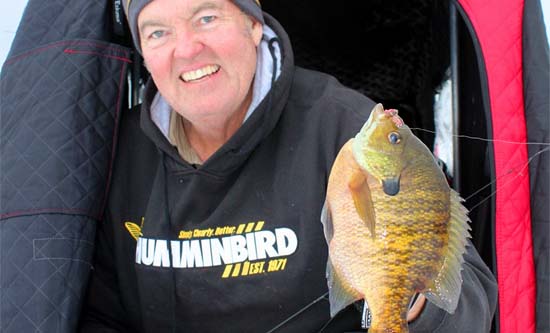Great late ice options should definitely include some bluegills. By late winter you can expect ‘gills to stay active and actually turn it up a notch and is when you can do plenty of catching. Some of their positive attitude can be attributed to diminishing snow cover and increasing light penetration which pumps up the oxygen levels. It’s a good situation for anglers who want to get in some serious pole bending before it all comes to a screeching halt.
 Finding hot pockets of late winter ‘gills isn’t all that tough and includes deeper flats near shallower summer haunts like weed covered beds and shallow vegetation. Midwinter bluegills can often be found holding on deeper flats and basin areas but will move back in when conditions start to change. Now you might find them in the middle of a shallow bay, on a ten or twelve foot shelve near a big weed bed, or even up in water six feet or less if you have some green weeds still standing which is a unique situation.
Finding hot pockets of late winter ‘gills isn’t all that tough and includes deeper flats near shallower summer haunts like weed covered beds and shallow vegetation. Midwinter bluegills can often be found holding on deeper flats and basin areas but will move back in when conditions start to change. Now you might find them in the middle of a shallow bay, on a ten or twelve foot shelve near a big weed bed, or even up in water six feet or less if you have some green weeds still standing which is a unique situation.
So how you will get some great late ice fishing bluegills?
Smaller bays are easy enough to check out and require fewer holes drilled and less time spent than it does checking out a bigger bay or a main lake flat. You can get in, drill some holes, and then drop some baits down and know if you’re on fish. If you are; they’ll move in and bite, period. If not; they won’t show themselves and they can’t bite if they’re not there and there is no jig or super bait that will change the outcome. And that’s the meat of the late ice program; drill some holes, drop down a bait, watch the depth finder, and then move on if nothing shows. And don’t let small fish keep you pinned down and wasting your time. Small perch can be a problem because they can be everywhere and will come and look and follow and make you think you’re on fish. I can see the size difference on my Humming bird 597 and bluegills will show up as thick red marks and if the fish aren’t marking big and red they’re not what I’m looking for. Lots of small perch doesn’t mean you have to give up on a spot right away but if the good marks don’t move in and bite in short order it’s probably time to move on. When you do pop a good fish it would be a good idea to drill some more holes because ‘gills are almost always moving. They might not move that far and that fast but they don’t often stay in one place for very long. It could be the way they feed (always moving and looking for something to eat), or it could be the northern pike that are constantly on their heels that keeps them going. Whatever the case they do move and they can certainly be back again but waiting it out is usually not nearly as productive as trying to stay with them.
The super shallow weed pattern mentioned exists when you have some current that helps to keep weeds alive and is when sight fishing can be a real hoot. Bluegills will hold in and around the weed beds and at times cruise right over the tops which can be just under the ice and puts them right below your feet where you can actually see them and almost reach out and touch them. It’s a super fun pattern and gives you the feel of fishing in an aquarium. It also lets you see just how bluegills size up your bait and just how finicky they can be. Get it right and you’re in for some real fun, get it wrong and you won’t hook that many which can be frustrating when you’re seeing a lot of fish. “Right” means super light line like one or two pound test and teeny tiny jigs tipped with a maggot. A 1/64oz jig head tipped with plastic can get it done (like a Little Atom Micro-Nuggie) but it would be a good idea to have some bugs with as well. When you’re that close to the fish and that shallow they can see imperfections in your presentation you have to have your act together to get it done. A rod and reel that can handle the light line and has a soft enough action to help keep you from breaking fish off includes the Black Betty from 13 Fishing combined with a twenty inch super ultra-light Wicked rod.
Sight fishing also requires fishing in the dark and shutting out as much light as you can and is when a portable shelter like the Eskimo Wide 1 Inferno can make a big difference. It has a black interior which absorbs light and keeps it out and makes it easier to keep an eye on the fish and helps to keep them from seeing you.
The late ice patterns will be here and gone before you know it so don’t delay. With a box of bugs and a few jigs and plastic bodies you can be living large and put a fitting end to the hard water season. See you on the ice.

